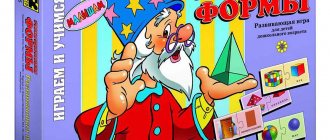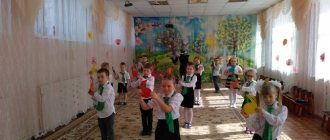Basic approaches to the classification of didactic games in the senior group
DIs are classified according to various criteria. They are divided by:
- the nature of the pedagogical process;
- game technique;
- gaming environment.
Note! Despite the different approaches to classification, every teacher needs to remember that play is not just a child’s activity. It is primarily expressed in the attitude and behavior of adults and is recurrent and permanent in nature.
Contents and selection of materials for the game
DI can be used both in relevant classes and outside educational activities. Depending on where the game is used, its duration is determined.
Preparing for DI
Class structure:
- First of all, a didactic task is determined, which is presented in the form of a game task and set by the teacher.
- Game actions are determined. The older group of kindergarten can independently determine their circle.
- Rules are set. Most often, the teacher sets them, but if the students come up with their own, the teacher can accept them.
- The result of the game is determined.
All didactic games include the main stages:
- the topic and content are communicated;
- participants get acquainted with the game material;
- familiarization with the rules is carried out;
- game actions are performed;
- the results are summed up.
Note! If something in the game did not work out for the child, then after summing up the results, the teacher can continue a personal discussion and analysis of mistakes in each specific case.
In conclusion, the teacher must motivate the students to achieve success in the future.
The role of the teacher in organizing classes
In the process of organizing and conducting didactic games, it is the teacher who must lead the entire process. He is obliged to ensure the direct and active participation of each child.
The role of the educator in the organization of DI
The teacher must think through and organize the entire process in such a way as to ensure that the game is connected with the learning and other activities of the students. Create conditions so that the process turns into an independent activity for children.
Note! The teacher needs to interest children in games. This can only be achieved if there is a sufficient amount of teaching material and toys. At the end of the game, the teacher must give not only an impartial, but also a friendly assessment.
The importance of didactic games in the senior group of kindergarten
DI is used for the purposes of teaching and raising children. With their help, specific learning tasks are solved, and certain skills are nurtured and developed.
DI in the older group
Didactic games for preschool age in preschool educational institutions
The purpose and objectives of the didactic game in the senior group of preschool educational institutions
Making the learning process interesting, simple and non-tiring is the main goal of such classes. The tasks of the didactic game for the senior group of preschool educational institutions are varied. They primarily depend on the requirements of the program and educational field, as well as on how children perceive the material.
If students quickly master knowledge and successfully master the material, then when repeated, the tasks expand.
Note! Otherwise, if children do not master the material well, then the gameplay is carried out with the same software tasks, and their content changes.
DI tasks are inextricably linked to the topic. All material is divided into thematic blocks. Work on one topic lasts from several weeks to one month. Therefore, in one year, many training sessions on various topics are conducted with children and the entire volume of tasks provided for in the program is completed.
DI tasks
Note! In older groups of preschool educational institutions, puzzles, charades, rebuses and intellectual tasks are useful, as they stimulate thought processes and teach children to think creatively and outside the box.
The educational role of games in older preschool age
From early childhood, play has a positive impact on children. As for older preschool age, during this period of time such activities cultivate the following qualities in the child:
- The ability to accept both victory and defeat with dignity.
- A sense of community and camaraderie.
- Honesty.
- Mutual respect.
- Decency.
- Partnerships.
In the senior group of the kindergarten, various games are played; the emphasis is primarily on educational games, as the children are prepared for school.
Consultation “Methodology for conducting didactic games with children of senior preschool age”
Olga Mikhailovna Petrova
Consultation “Methodology for conducting didactic games with children of senior preschool age”
Consultation for teachers
Preschool age is a period of intense and rich emotional life, wild flowering of creative imagination, a period of discovery of the world in its pristine beauty and purity.
During this period, the leading activity of the child is play. What do preschoolers most of their lives? They are playing. And they play everything. In play, a child easily learns about the world around him, acquires new knowledge, and develops.
A special place in the process of educating a preschooler is occupied by didactic games . It is a game form of learning in which two principles operate simultaneously: educational, cognitive and playful, entertaining. This is due to the need to soften the transition from one leading activity to another, as well as the fact that in the process of play, children more easily acquire knowledge and gain ideas about the life around them. Unlike educational activities, in a didactic game, educational and cognitive tasks are not set directly, when the teacher explains and teaches, but indirectly - children acquire knowledge by playing.
of educational games:
1. Didactic games with objects are very diverse in terms of game materials, content, and organization . Toys, real objects, and natural objects are used as teaching
— plot-based didactic games : children play certain roles, for example, seller, buyer in games like “Shop”
and etc.
— Dramatization games help clarify ideas about various everyday situations, literary works, and norms of behavior.
2. Printed board games are varied in type: paired pictures, lotto, dominoes. They are based on the principle of clarity, but children are given not the object itself, but its image.
3. Word games are distinguished by the fact that the process of solving a learning task is carried out in a mental way, based on ideas and without relying on visualization.
The structure of the didactic game includes:
1. Didactic task - emphasizes the educational nature of the game, the focus of the content on the process of cognitive activity, follows from the education and training program in kindergarten,
2. Game task - determines game actions, becomes the task of the child himself, causes the desire and need to solve it.
3. Game actions - the basis of the game, its plot, the manifestation of activity by children for gaming purposes .
4. Game rules - determine what and how each child needs to do in the game, indicate the path to achieving the goal, develop the ability to restrain himself, and manage his behavior.
Not only at older ages , but also in all age groups, teachers take into account general rules in which:
1. It is necessary to create conditions for games.
2. Care should be taken to constantly enrich children's gaming experience
3. The teacher should always be focused on developing children’s independence, self-organization skills, and creative attitude to play.
Conducting a didactic game can be divided into three stages, where each stage of the game corresponds to certain pedagogical tasks. At the first stage, this is preparation for conducting a kindergarten , where the teacher interests the children in the game, creates a joyful expectation of a new game, and evokes a desire to play. The second stage is conducting a d/i , where the teacher acts not only as an observer, but also as an equal partner who knows how to come to the rescue in a timely manner and fairly assess the children’s behavior in the game. And the third stage includes the analysis of the game, where the role of the teacher is to evaluate children's creativity when solving game problems.
Preparation for conducting a didactic game includes :
– choosing a game in accordance with didactic objectives ;
– determining the place and role of play in the system of education and upbringing;
– preparation of play equipment;
– determination of the game time in the daily mode.
Conducting didactic games includes:
– familiarizing children with the content of the game, with the didactic material that will be used in the game (showing didactic material , a short conversation, during which the children’s existing knowledge and ideas are clarified);
– an explanation of the course and rules of the game, during which the teacher draws attention to the need to strictly follow the rules;
– determination of the role of the teacher in the game: his participation as a player, fan or referee (the extent of the teacher’s participation in the game depends on the age of the children , their level of training, the complexity of the didactic task , and game rules).
– determination of the number of players;
– developing a playful mood and desire to play in children;
– managing the course of the game, ensuring the activity of all children, providing assistance to those in need;
- summing up the game.
Game analysis is aimed at:
– to identify methods of its preparation and implementation ;
– to identify individual characteristics in the behavior and character of children;
– complicating the game and enriching it with new material.
When conducting a didactic game when working with preschool children, the teacher must comply with the following conditions:
– clearly, emotionally and expressively explain to children the task and rules of the game;
– take the position of an equal partner in the game, empathize with the players, react vividly and emotionally to the progress of the game, maintain interest in the actions of each child;
– introduce elements of competition into the game, fun competitiveness between teams, encourage fans who emotionally support the players;
– give each child the opportunity to be in the role of both a participant and a leader of the game; ensure constant change of playing roles;
– vary the tasks and rules of the game, developing the ability to arbitrarily rearrange one’s behavior in accordance with changes in the game content;
– implement an individually differentiated approach to children through the variability of game tasks and rules;
– means and methods that increase children’s emotional attitude to the game should be considered not as an end in itself, but as a path leading to the fulfillment of didactic tasks ;
– the visualization used in the didactic game should be accessible and capacious.
A mandatory requirement for didactic games is the active participation of the child in them. Sometimes in practice, playing games comes down to the fact that the teacher plays, and the children only watch. Such games are ineffective. The teacher should not do anything for the child in the game, he only needs to help. Training should take place in a relaxed, playful form and be unnoticeable. It is necessary to create conditions for games: select appropriate didactic material and didactic toys and games. Think about how to place teaching materials and toys so that children can use them freely; provide a place to play.
Let's consider several options for organizing the work of a teacher to teach children the ability to set game tasks. The choice of one or another version of the manual will depend on the children’s existing gaming skills.
1. The child does not know how to set game tasks and for this reason does not join the game. In a game, an adult and a child solve it together, while the initiative first belongs to the adult, he is the bearer of the gaming experience.
2. The child already has little gaming experience, which is expressed in the fact that sometimes he independently sets gaming tasks, and sometimes experiences difficulties. The joint game is organized in such a way that the initiative first belongs to the adult, he prompts and advises. Gradually, the initiative passes to the child.
3. The child has mastered the ability to set game tasks, and therefore in games he sets them independently. An adult does not ignore a playing child; he encourages him, approves of him, and instills confidence. In such cases, the play initiative belongs to the child; he plays alone; an adult can join the game to assist in setting a new original, in other words, initiative play task.
The teacher leads the didactic game in different ways : in the classroom he introduces children to the rules and game actions, and in independent games he participates as a partner or referee, monitors the relationships between children , and evaluates their behavior.
At an older age, the rules are explained before the game, as a rule, without showing their implementation.
• The teacher does not take part in the games, but monitors the implementation of the rules of the game, the progress of the game,
• In didactic games, educators put the child in such conditions (game conditions) when he is forced to remember what he was told in practice.
• Knowing the individual characteristics of children, the teacher advises them to distribute roles in the game among themselves.
• When finishing the game, the teacher should remind the children the name of the game, individual game rules, and support the children’s interest in continuing the game.
• When playing the game again, the children learn the full order, game rules and methods of action.
Thus, in work, the teacher actively manages the didactic game , organizes it, and monitors its progress; takes direct part, observes the progress of the game, and, if necessary, and sometimes at the request of the children, provides assistance to the players.
Types of didactic games in the senior group of kindergarten
Didactic games in the senior group are divided into several varieties.
Types of didactic games
They are distinguished by the following criteria:
- educational content;
- cognitive activity;
- game actions and rules;
- children's organizations;
- role of the teacher.
The listed differences are inherent in all didactic games, but they appear more clearly in some than in others. Games are also classified:
- on sensory education;
- to get acquainted with nature and the surrounding world;
- on the formation of mathematical concepts;
- verbal;
- musical;
- on literacy preparation;
- figurative;
- with educational toys;
- pseudo-plot;
- desktop-printed.
By type of activity, game processes are as follows:
- trips;
- instructions;
- offers;
- puzzles;
- conversations or dialogues.
Note! The classification does not end there. The entire range of possible gaming techniques is huge. But as practice shows, the ones listed above are most often used.
Card index of educational games in the senior group of preschool educational institutions with goals according to the Federal State Educational Standard
Important! Modern kindergartens carry out their activities in accordance with the standards of the Federal State Educational Standard. When developing a thematic plan, each educator must take into account and implement learning activities in accordance with the requirements of the standard.
DI card index






